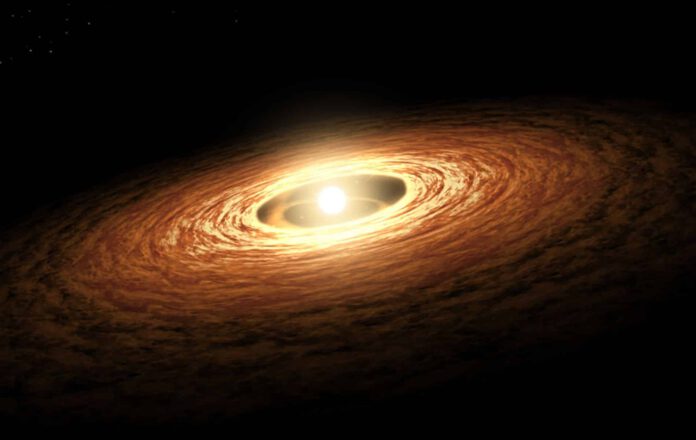
Discovery Beyond Our Solar System
Astronomers have made an intriguing discovery some 650 light-years away in the southern constellation of Chamaeleon. The young star ISO-ChaI-147, significantly lighter than our sun, has revealed groundbreaking findings about its surrounding disk, thanks to observations made with the James Webb Space Telescope. Researchers have discovered for the first time the presence of ethane outside our solar system.
Protoplanetary Disk
Planets form in disks of gas and dust that orbit young stars. Around ISO-ChaI-147, scientists studied this planet-forming disk, finding it surprisingly rich in hydrocarbons. Lighter stars tend to harbor more Earth-like planets compared to heavier ones, making the study of these lighter stars critical for understanding planet formation. However, their composition has largely remained a mystery until now.
Hydrocarbons
Using the MIRI instrument aboard the James Webb Telescope, researchers discovered an abundance of hydrocarbons in the disk around ISO-ChaI-147, identifying thirteen different types. The largest molecule found was benzene (C6H6), previously detected around another light, young star. Most remarkably, ethane (C2H6) was detected for the first time outside our solar system.
New Discoveries
The team also successfully identified ethylene (C2H4), propylene (C3H4), and the methyl radical (CH3) within the protoplanetary disk. “These molecules had been observed in our solar system, in comets like 67P/Churyumov-Gerasimenko and C/2014 Q2 (Lovejoy),” says lead author Aditya Arabhavi from the University of Groningen. “It’s exciting to observe how these molecules behave in the birthplace of planets.”
Distinct Differences
The discovery of this range of hydrocarbons confirms that disks around light, young stars are fundamentally different from those around sun-like stars, which typically contain more oxygen-bearing molecules like water and carbon dioxide. “It’s fantastic to have discovered these molecules,” says Arabhavi. “We couldn’t have dreamed of this outcome.”
Chemical Diversity
Why is the disk around ISO-ChaI-147 so rich in hydrocarbons? Researchers suggest that carbon may be extracted from the solid material forming rocky planets. This could explain why Earth is relatively carbon-poor, and imply that Earth-like planets around lighter stars might be chemically diverse from those in our solar system. “It’s fascinating to speculate on these differences,” notes co-project leader Inga Kamp.
Role of James Webb Telescope
This research was only possible due to the James Webb Space Telescope’s sensitivity and spectral resolution, explains Arabhavi. “These observations can’t be made from Earth as the emissions are blocked by the atmosphere. Previously, we could only identify acetylene (C2H2) emissions from this object. Now, thanks to the Webb telescope, we can detect weaker emissions from less common molecules, offering a better understanding of the diversity and abundance of hydrocarbons.”
Future Research
The team plans to expand their research by studying more similar disks around light stars. They aim to understand how common such carbon-rich regions are for forming Earth-like planets. “By broadening our research, we can gain deeper insights into molecular formation processes,” says team member Thomas Henning. “We haven’t yet fully interpreted all Webb’s data, so further spectroscopic research is necessary.”
The researchers aim to analyze over fifty dust disks around young stars, expecting to discover more molecules and deepen their understanding of rocky planet formation around both small and large stars.











